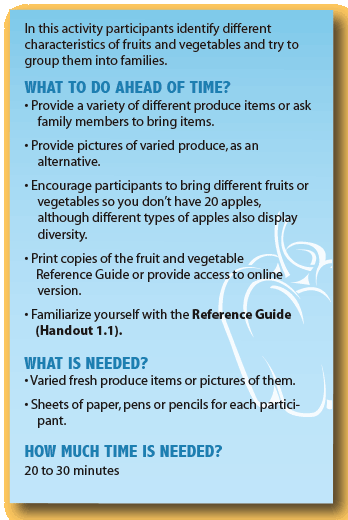
Activity 1.1: Who Is Related?

Directions
Put fruits and vegetables in the middle of the floor. In small groups, participants can pick up individual items one at a time; in larger groups the leader can pick up the items. Then ask the group the following:
- Can you identify different characteristics of the food, like its color, shape, size, smell, taste (sweet or sour), skin thickness, texture, noticeable markings or sections?
- Based on what you know or observed about these fruits and vegetables, explain where you think they grow. On a tree, on a vine, on a plant stem? Does it grow above or below the ground?
Have each student write down the different characteristics that are identified for each food. (This list can be used in Activity 1.2 and the application activity in Dessert.) Remind the participants that the different characteristics are linked to different genes in the plant that specify what the food looks, tastes and smells like.
Once characteristics have been described, ask the participants to group foods together that seem related, based on common characteristics. See Fruit and Vegetable Families Reference Guide. Even more vegetable families are at the Gardening Data website or the Vegetables Only website.
Participants will likely group fruits and vegetables in ways different from those shown in the Reference Guide. For example, tangerines and nectarines are both orange in color; onions and carrots both grow in the ground. But neither of these groups are members of the same family.
Don't discourage participants from trying to find similarities in their fruits and vegetables even if they are not related. You can explain that, if they look at other characteristics, such as seeds, a tangerine is more like an orange than a nectarine. The way the seeds look and are arranged in the fruit is specified by genes and the similarity means that likely oranges and tangerines have some genes that are alike - but also some are different since they don't taste the same. Arrange produce according to degree of similarity based on whatever characteristics the participants choose. Then use the guide in Handout 1.1 to show the true family relationships.
Next: Activity 1.2: What Am I?